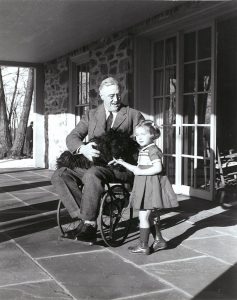Franklin D. Roosevelt, later the 32nd president of the United States (1933 -1945), began experiencing symptoms of a paralytic illness in 1921 when he was 39 years old.
His main symptoms were fever; symmetric, ascending paralysis; facial paralysis; bowel and bladder dysfunction; numbness and hyperaesthesia; and a descending pattern of recovery.
 Rare photograph of Roosevelt in a wheelchair, with Ruthie Bie and Fala (1941)
Rare photograph of Roosevelt in a wheelchair, with Ruthie Bie and Fala (1941)
He was diagnosed with poliomyelitis and underwent years of therapy, including hydrotherapy at Warm Springs, Georgia.
Roosevelt remained paralysed from the waist down and relied on a wheelchair and leg braces for mobility, which he concealed in public. Few people in the world were aware of disability during WW2; as he needed to show strength as one of the three major Allied world leaders, with Churchill and Stalin.
In 1938, he founded the National Foundation for Infantile Paralysis, leading to the development of polio vaccines.
Although historical accounts continue to refer to Roosevelt’s case as polio, the diagnosis has been questioned in the context of current medical science, with a competing diagnosis of Guillain–Barré syndrome proposed by some authors.

